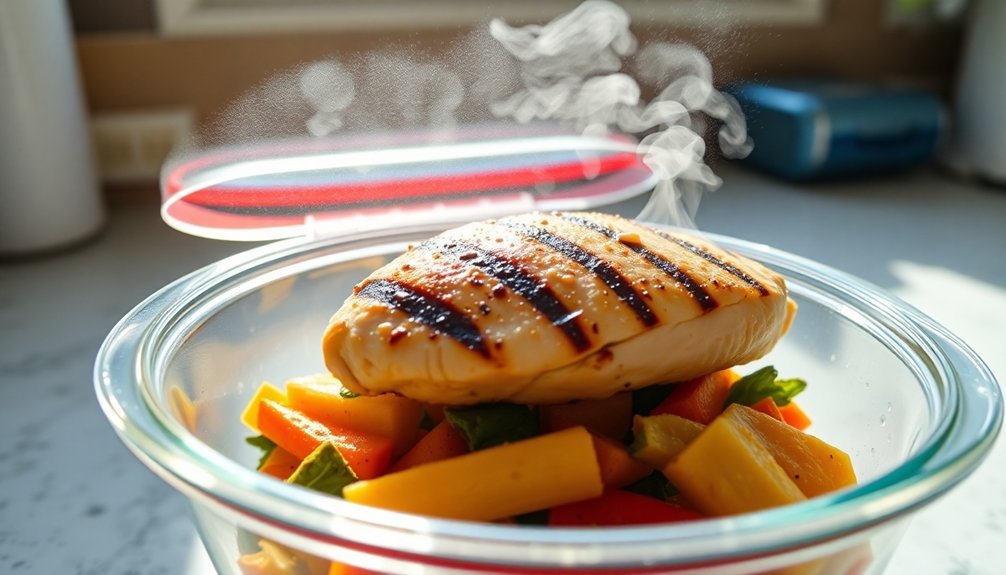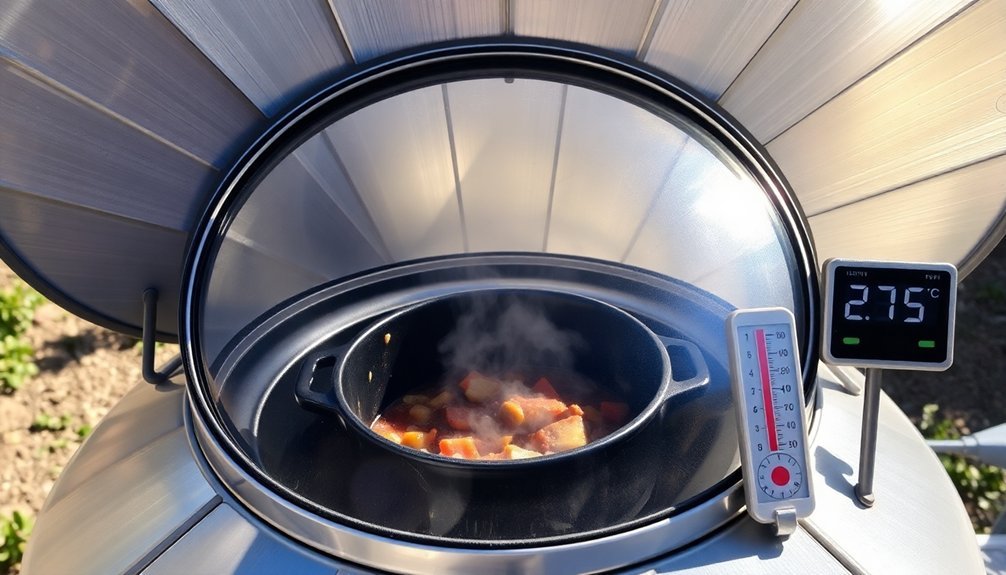Proper sealing is essential for your sun-baked meals because it directly controls moisture and maintains cooking efficiency. When you're using a solar oven, trapped steam can condense on glass surfaces and block sunlight, reducing cooking performance by up to 25% if not managed correctly. You'll want to prevent moisture loss while avoiding excess condensation that could compromise your food's quality and increase spoilage risk. Using effective sealing techniques and materials like double glazing can extend food freshness up to five times longer while preserving nutrients and flavors. Understanding the right sealing methods will transform your solar cooking results.
Understanding Solar Oven Moisture Control

While solar ovens offer an eco-friendly cooking method, managing moisture is vital for their effectiveness. As your food cooks, it releases steam that gets trapped inside the oven, similar to how a bathroom mirror fogs up during a hot shower.
This trapped moisture condenses on the glass cover, creating a barrier that blocks sunlight from reaching your food. You'll need to monitor and control this steam buildup to maintain ideal cooking conditions. Opening the lid during cooking can cause a 25-degree heat loss.
The condensation can notably reduce your solar oven's efficiency by preventing sunlight from penetrating the cooking chamber. Understanding this moisture cycle is essential because it affects both cooking time and food quality.
Unlike conventional ovens that easily release steam, solar ovens require specific strategies to manage moisture while retaining the heat needed for proper cooking.
Essential Sealing Materials
Three key categories of sealing materials help maintain moisture control in your solar oven: structural components, insulation barriers, and transparent glazing.
For structure, you'll need durable materials like cardboard, wood, metal, or glass that won't lose their shape over time. These create your oven's foundation but aren't great insulators on their own.
That's where insulation materials come in – aluminum foil, rockwool, or even natural options like straw and rice hulls will surround your cooking cavity to minimize heat loss. Similar to how rolled-up windows in a car trap heat on a sunny day, proper insulation helps maintain cooking temperatures.
Your glazing choice is essential for the greenhouse effect. You can use glass or high-temperature plastics like oven bags.
Double glazing cuts heat loss in half, though it'll reduce solar transmission by 5-15%.
Don't forget quality adhesives like white glue or flour paste to seal any gaps that could let moisture escape.
Proper Sealing Techniques

You'll need to start by wrapping your sun-baked meals using vacuum or heat sealing methods, ensuring the edges remain free from moisture and food particles.
To create an effective seal, leave adequate space at the top of your packaging and consider using the double seal technique for items containing liquid.
Test the seal's integrity by gently pressing around the edges and checking for any air pockets or weak spots that could compromise freshness. Implementing Modified Atmosphere Packaging can further extend the shelf life by replacing regular air with protective gases.
Essential Wrapping Methods
Proper sealing techniques play an essential role in preserving sun-baked meals for extended periods.
You'll want to focus on vacuum sealing to protect your moist sun-baked dishes from spoilage and contamination. This method removes air that could promote bacterial growth while creating an airtight environment.
- Check seals carefully for trapped food particles that could compromise preservation
- Store sealed meals in cool, dry places away from direct sunlight
- Use durable plastic pouches designed specifically for vacuum sealing
- Consider combining vacuum sealing with heat sealing for extra protection
- Inspect packaging materials before sealing to guarantee they're moisture-free
For best results, you'll need to maintain proper sealing temperatures and pressure levels throughout the process.
Remember that improper sealing can lead to contamination and reduced shelf life of your sun-baked creations.
Tight Seal Testing
Testing the integrity of your vacuum-sealed meals requires both visual inspection and specialized leak detection methods.
While you'll want to start by checking for visible defects like gaps, cracks, or misalignments, don't rely on visual inspection alone, as it won't reveal microscopic leaks that could compromise your food's safety.
You'll need to employ objective testing techniques to guarantee your sun-baked meals stay fresh and contamination-free.
Consider using bubble leak testing, pressure decay testing, or FDA-recognized vacuum decay testing for quantitative results.
These methods will help you verify that your seals can withstand environmental stressors during storage and shipping.
Moisture Retention Benefits
Your sun-baked meals will stay fresh up to five times longer when you properly seal them with vacuum packaging.
The airtight seal prevents steam from escaping, keeping your food moist and flavorful throughout storage.
You'll notice better texture and taste in your meals since the sealed environment locks in essential moisture and prevents freezer burn.
Food Stays Fresh Longer
By utilizing vacuum sealing technology, you'll notice a significant improvement in how long your sun-baked meals stay fresh and moist. When you remove air from your food storage containers, you'll prevent bacteria growth and oxidation that typically cause food spoilage.
Your sun-baked meals will maintain their original flavors, nutrients, and textures for extended periods.
- Dramatically extends shelf life in your fridge, freezer, or pantry
- Eliminates freezer burn by preventing ice crystal formation
- Preserves essential nutrients and delicate flavors
- Reduces food waste and saves you money
- Keeps moisture locked in, maintaining food's original texture
You'll find that vacuum sealing isn't just about storage – it's about preserving the quality of your sun-baked meals. Without exposure to air, your food stays fresher longer, letting you enjoy your meals exactly as intended.
Prevents Steam From Escaping
When vacuum sealing sun-baked meals, proper steam management becomes essential for both safety and meal quality. You'll need to cut one corner of the vacuum-sealed bag when reheating in the microwave to prevent melting and allow steam to escape safely. This small modification helps avoid dangerous pressure buildup while maintaining the bag's protective benefits.
Your vacuum-sealed package creates an ideal environment where moisture and flavors can't escape during the cooking process. Instead, they circulate back into your food, ensuring it stays tender and flavorful.
This controlled moisture retention is particularly vital for sun-baked meals, which require specific moisture levels to maintain their intended texture. The vacuum seal also prevents unwanted air exposure that could compromise your meal's taste and quality.
Common Sealing Mistakes

Proper sealing techniques make the difference between perfectly preserved foods and spoiled supplies.
You'll need to avoid common mistakes that can ruin your sun-baked meals. Not removing air completely, using improper storage materials, and neglecting regular inspections can lead to food safety issues and quality deterioration.
- Don't overfill vacuum seal bags – leave adequate space at the top for a proper seal
- Avoid using permeable plastic bags that won't maintain food crispness
- Never skip post-sealing inspection for potential defects
- Keep dried foods in airtight, insect-proof containers to prevent contamination
- Remove air thoroughly before sealing to prevent staleness
Remember to cool dried foods completely before packaging and store them in the coolest area of your home.
Using the right sealing materials and techniques guarantees your sun-baked meals maintain their quality and safety.
Best Practices During Cooking
Beyond proper sealing techniques, successful sun-baked meal preservation starts with the cooking process itself. You'll need to guarantee your sun-baked dishes are completely cool and dry before sealing them to prevent moisture buildup and spoilage. Remove all excess moisture, and don't skip the cooling phase, as warm foods will create condensation.
| Process | Action | Purpose |
|---|---|---|
| Pre-Cook | Blanch vegetables | Reduce moisture content |
| During Cook | Use preservatives | Prevent spoilage |
| Post-Cook | Cool completely | Avoid condensation |
If you're working with particularly moist dishes, consider freezing them first before sealing. This prevents liquid from interfering with the seal. Always use clean, dry containers and avoid materials like copper or aluminum that might contaminate your sun-baked meals during storage.
Frequently Asked Questions
Can Different Types of Food Be Cooked Together in a Sealed Solar Oven?
Yes, you can cook different foods together in your solar oven if they have similar cooking times and temperatures. You'll need to adjust portion sizes and use dark pots to guarantee everything cooks evenly.
How Long Does a Plastic Wrap Seal Typically Last in Direct Sunlight?
You'll notice plastic wrap seals typically degrade within a few months in direct sunlight. However, if you're using UV-resistant polyethylene shrink wrap, it can last considerably longer, up to several years with proper care.
What Happens if Condensation Forms Inside the Sealed Cooking Container?
When condensation forms in your sealed container, you'll notice water droplets collecting on the lid and sides. It can make your food soggy, but it won't make it unsafe if you've stored it properly.
Should the Seal Be Adjusted During Cloudy Weather Conditions?
You don't need to adjust seals during cloudy weather conditions. The sealing process isn't affected by cloudiness, as it's designed to maintain food safety and prevent contamination regardless of weather conditions.
Can Sealed Solar Cooking Affect the Nutritional Content of Vegetables?
You'll preserve more nutrients in your vegetables with sealed solar cooking. It maintains vitamins and minerals by preventing steam loss, while the gentle, low-temperature cooking process helps break down carbohydrates without depleting nutritional value.
In Summary
Proper sealing is vital for your sun-baked meals' success. You'll want to guarantee your containers have tight-fitting lids and appropriate sealing materials to lock in essential moisture during the cooking process. When you've sealed your dishes correctly, you'll achieve better cooking results, maintain food safety, and prevent your meals from drying out. Don't forget to check seals regularly while cooking for peak moisture control.





Leave a Reply